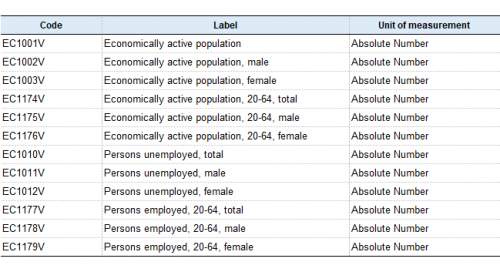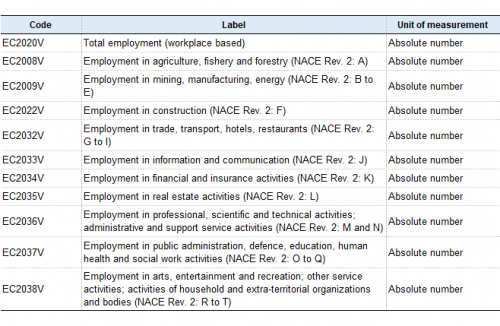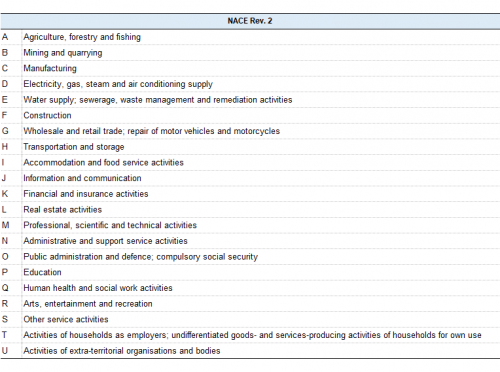City statistics – economic aspects
Planned article update: October 2024
Highlights
This chapter of the City statistics manual provides the definitions that should be used for compiling data at city and functional urban area level in the following sub-domains: Labour Market statistics and Employment by economic activity. In order to ensure comparability across countries, the recommended concepts and definitions are in line with the existing EU Regulations regarding the EU Labour Force Survey (LFS) and the Structural Business Statistics. Concepts and definitions regarding discontinued variables are not included in the chapter. The chapter also contains links to methodology, publications and external information.
Full article
Labour market statistics
Variables:
All variables under the heading of Labour Market Statistics are residence based, not workplace based. The data provided shall take into account the people living in the city/Functional Urban Area, irrespective of their work place. Labour market concepts and definitions are in accordance with the International Labour Organisation (ILO) standards and the European Union Labour Force Survey legislation. Since the Labour Force Survey is, in general, designed to produce data at NUTS level 2, reliability of aggregates based on NUTS level 3 data (such as statistical information at city/Functional Urban Area level) may be limited.
Employment (persons employed) (EC1077V to EC1079V): Persons of the relevant age group who during the reference week performed work for pay or profit or family gain for at least one hour, or were not working but had a job or business from which they were temporarily absent for example due to illness, holidays, industrial dispute and education and training.
Unemployment (persons unemployed) (EC1010V to EC1012V): Persons aged 15 to 74 who were:
(1) not employed according to the definition of employment.
(2) currently available for work, i.e. were available for paid employment or self-employment before the end of the two weeks following the reference week.
(3) actively seeking work, i.e. had taken specific steps in the four-week period ending with the reference week to seek paid employment or self-employment or who found a job to start later, i.e. within a period of at most three months from the end of the reference week[1].
Economically active population (EC1001V to EC1003V and EC1174V to EC1176V): Persons that are either employed or unemployed and not part of the population outside the labour force (also called economically inactive population), which covers all residents over 15 who are not economically active, eg. students, long term sick, permanently disabled, retired people, national armed services and those not seeking to enter the labour market). Regarding the national level data on employment, unemployment and active population that is presented in conjunction with the urban level data, the average from the data available on a quarterly basis should be taken.
Employment by economic activity
Variables:
Due to the implementation of the NACE Rev. 2 activities, an adjustment of the activity categories was necessary. The breakdown in 10 large industries (activities) is done according to regional accounts statistics. This called for the deletion of some existing categories and the integration of several new categories (according to NACE Rev.2). For all new NACE Rev. 2 categories the corresponding indicators will be calculated. NACE Rev. 2 section 'U - Activities of extraterritorial organisations and bodies' should be excluded.
The main categories are listed in the following Table:
For regional and city statistics, the employment by NACE sector should ideally be reported at the level of the local unit, rather than at the level of company (enterprise).
The enterprise is the smallest combination of legal units that is an organisational unit producing goods or services, which benefits from a certain degree of autonomy in decision-making, especially for the allocation of its current resources. An enterprise carries out one or more activities at one or more locations. An enterprise may be a sole legal unit. The local unit is an enterprise or part thereof (e.g. a workshop, factory, warehouse, office, mine or depot) situated in a geographically identified place. At or from this place, economic activity is carried out for which - save for certain exceptions - one or more persons work (even if only part-time) for one and the same enterprise.
For detailed information on statistical units, please see Council Regulation (EEC) No 696/93 of 15 March 1993 on the statistical units for the observation and analysis of the production system in the Community (Official Journal of the European Communities No L 076, 30/03/1993, p. 1), Section III of 15.03.1993 on the statistical units for the observation and analysis of the production system in the Community.
Commission Regulation (EC) No 250/2009 of 11 March 2009 implementing Regulation (EC) No 295/2008 of the European Parliament and of the Council as regards the definitions of characteristics, the technical format for the transmission of data, the double reporting requirements for NACE Rev.1.1 and NACE Rev.2 and derogations to be granted for structural business statistics.
Employment (number of persons employed in the local units at the territory of the reported city and functional urban area) is defined as the total average number of persons who work in the observation unit (inclusive of working proprietors, partners working regularly in the unit and unpaid family workers), as well as persons who work outside the unit who belong to it and are paid by it (e.g. sales representatives, delivery personnel, repair and maintenance teams). The number of persons employed excludes manpower supplied to the unit by other enterprises, persons carrying out repair and maintenance work in the enquiry unit on behalf of other enterprises, as well as those on compulsory military service.
As one may possess second, third, etc. jobs in different enterprises, one person may be counted more than once. This means that employment by economic activity, in the context of city statistics, does not refer to the “head count” of persons employed in a certain city (functional urban area), but instead for the number of jobs.
Please note: The preferred data source for all variables under the heading of Employment by economic activity is the Business register. The information in the Business register is used for a sample of the total target population of enterprises for different sample surveys in the business statistics such as the Structural business statistics. If a country uses the LFS as data source for these data, the information should be aggregated using the workplace addresses of the respondents not the place of residence.
Direct access to
Database
- City statistics (urb), see:
- Cities and greater cities (urb_cgc)
- Functional urban areas (urb_luz)
- Perception survey results (urb_percep)
Dedicated section
Publications
Methodology
Visualisations
External links
This article forms part of Eurostat’s City statistics manual.



